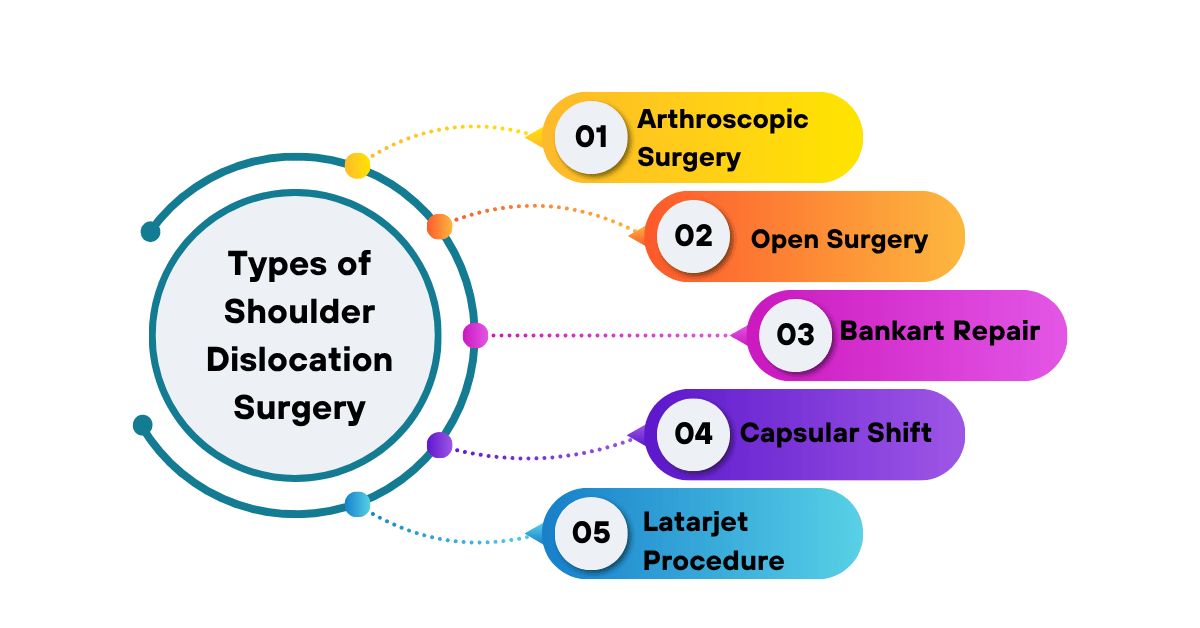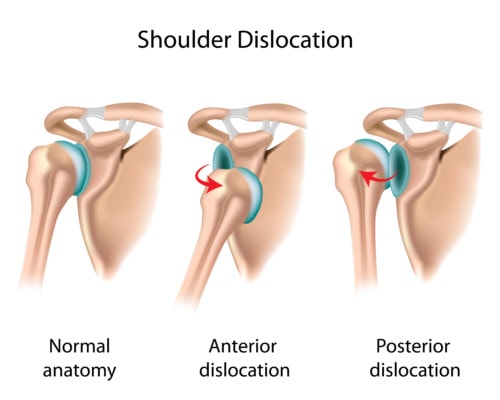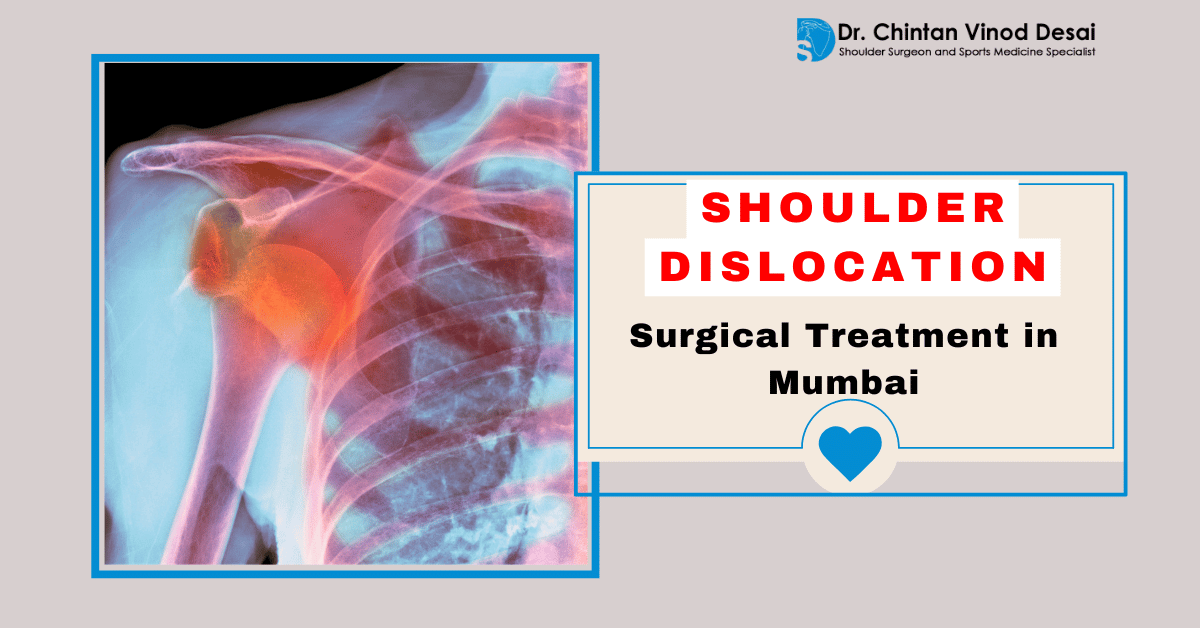Shoulder dislocation occurs when the ball of the upper arm bone moves out of its socket. This injury is common in sports and accidents. It is extremely painful and can lead to long-term complications if not treated properly. In some cases, surgery is the best option to restore shoulder function and prevent further damage. This blog will explain shoulder dislocation, the need for surgery, and what to expect from surgical treatments in Mumbai.
What is Shoulder Dislocation?

The shoulder joint is a ball-and-socket joint that allows for a wide range of motion. The ball (head of the humerus) fits into a shallow socket (glenoid) of the shoulder blade. When the ball moves out of the socket, it causes a dislocation. Dislocations can be caused by falls, accidents, or heavy impact.
The injury can cause severe pain, limited movement, and deformity. The shoulder may appear flattened or out of place. In some cases, there may be nerve or blood vessel damage. Surgeons treat most dislocations with non-surgical methods, but they perform surgery for recurrent dislocations or significant damage to the shoulder structures.
When is Surgery Needed for Shoulder Dislocation?
Not all shoulder dislocations require surgery. Many cases treat with conservative methods, such as rest, ice, and physical therapy. Doctors consider surgery when:
- Recurrent Dislocations: If the shoulder frequently dislocates, doctors often perform surgery to stabilize the joint. Repeated dislocations can damage the tissues and ligaments, making the joint prone to further injury.
- Severe Damage: If the dislocation significantly damages the bones, ligaments, or cartilage of the shoulder, the doctor will perform surgery to repair the damage.
- Failure of Non-Surgical Treatments: If rest, ice, and physical therapy do not relieve pain or restore function, surgery may be the best option to restore shoulder stability.
Types of Shoulder Dislocation Surgery
Several surgical techniques are used to treat shoulder dislocations. The choice of surgery depends on the severity of the injury and the patient’s needs.

- Arthroscopic Surgery
- Arthroscopy is a minimally invasive procedure where the surgeon inserts a small camera (arthroscope) into the shoulder through tiny incisions. The surgeon can then see the joint on a monitor and repair the damage without the need for large incisions.
- This procedure is often used to repair soft tissue damage, such as tears in the labrum (cartilage) or rotator cuff. It offers a quicker recovery time and less pain compared to traditional surgery.
- Arthroscopy is a minimally invasive procedure where the surgeon inserts a small camera (arthroscope) into the shoulder through tiny incisions. The surgeon can then see the joint on a monitor and repair the damage without the need for large incisions.
- Open Surgery
- In open surgery, the surgeon makes a larger incision to directly access the shoulder joint. This is typically needed when the damage is extensive, such as fractures or large tears in the muscles or ligaments.
- Open surgery may require a longer recovery period and carries more risks of infection and complications compared to arthroscopic surgery.
- In open surgery, the surgeon makes a larger incision to directly access the shoulder joint. This is typically needed when the damage is extensive, such as fractures or large tears in the muscles or ligaments.
- Bankart Repair
- The Bankart repair is a surgical procedure commonly used to treat recurrent shoulder dislocations. It involves repairing the labrum, the cartilage ring around the shoulder socket. The labrum is reattached to the socket to prevent the ball from slipping out of place.
- This procedure is effective for individuals who have had multiple dislocations and have damage to the labrum.
- The Bankart repair is a surgical procedure commonly used to treat recurrent shoulder dislocations. It involves repairing the labrum, the cartilage ring around the shoulder socket. The labrum is reattached to the socket to prevent the ball from slipping out of place.
- Capsular Shift
- In this surgery, the surgeon tightens the capsule around the shoulder joint to stabilize it. The capsule is the connective tissue that holds the shoulder in place. This surgery is often used when the shoulder capsule is too loose from repeated dislocations.
- The procedure reduces the chance of further dislocations by tightening the shoulder’s surrounding tissue.
- In this surgery, the surgeon tightens the capsule around the shoulder joint to stabilize it. The capsule is the connective tissue that holds the shoulder in place. This surgery is often used when the shoulder capsule is too loose from repeated dislocations.
- Latarjet Procedure
- The Latarjet procedure is performed when there is significant bone loss in the shoulder joint. This surgery involves transferring a piece of bone from the shoulder blade to the front of the socket to provide additional stability.
- The Latarjet procedure is effective for patients with significant damage to the bone or soft tissue and is often used for athletes or active individuals who require a stable shoulder joint.
- The Latarjet procedure is performed when there is significant bone loss in the shoulder joint. This surgery involves transferring a piece of bone from the shoulder blade to the front of the socket to provide additional stability.
Dr. Chintan Vinod Desai: Leading Shoulder Surgeon in Mumbai
Dr. Chintan Vinod Desai is a highly experienced and skilled shoulder surgeon based in Mumbai. He practices in various locations, including Tardeo, Parel, Dadar, Mumbai Central, Lalbaug, Santacruz, and Mulund. With years of expertise, Dr. Desai is known for his excellence in treating shoulder conditions, including instability, frozen shoulder, impingement, rotator cuff tears, shoulder arthritis, and calcific tendonitis.
Dr. Desai uses the latest techniques in shoulder surgery to provide the best outcomes for his patients. Whether it is arthroscopic surgery or open surgery, he tailors the treatment plan based on the specific needs of the patient. Dr. Desai’s goal is to help patients regain full function of their shoulder joint while minimizing the risk of further dislocations.
What to Expect Before, During, and After Shoulder Surgery
Understanding what to expect before, during, and after shoulder surgery can help ease any concerns. The process typically involves the following steps:

- Before Surgery
- Pre-operative assessment is crucial to ensure the patient is healthy enough for surgery. This may include blood tests, imaging (X-rays, MRI), and a physical exam.
- The surgeon will discuss the surgical options, potential risks, and expected outcomes. You will also receive instructions on how to prepare for surgery, such as fasting before the procedure.
- Pre-operative assessment is crucial to ensure the patient is healthy enough for surgery. This may include blood tests, imaging (X-rays, MRI), and a physical exam.
- During Surgery
- Shoulder surgery is typically performed under general anesthesia. This means the patient will be asleep during the procedure and will feel no pain.
- The surgical procedure depends on the type of surgery being performed. Arthroscopic surgery involves small incisions and the use of a camera, while open surgery requires larger incisions to access the shoulder.
- Shoulder surgery is typically performed under general anesthesia. This means the patient will be asleep during the procedure and will feel no pain.
- After Surgery
- After the surgery, the doctor will immobilize the shoulder in a sling to help the joint heal. The doctor will prescribe pain medication to manage discomfort.
- The first few days after surgery will involve rest and ice to reduce swelling. Physical therapy will begin once the shoulder has healed enough to start restoring strength and mobility.
- After the surgery, the doctor will immobilize the shoulder in a sling to help the joint heal. The doctor will prescribe pain medication to manage discomfort.
- Rehabilitation
- Physical therapy is crucial after shoulder surgery. The therapist will guide you through exercises to improve range of motion, strength, and flexibility in the shoulder.
- The recovery period varies depending on the type of surgery performed. Full recovery can take anywhere from 3 to 6 months, with regular follow-up visits to the surgeon to monitor progress.
- Physical therapy is crucial after shoulder surgery. The therapist will guide you through exercises to improve range of motion, strength, and flexibility in the shoulder.
FAQs on Shoulder Dislocation Surgery
- How long does it take to recover from shoulder surgery?
- Recovery time depends on the type of surgery. Arthroscopic surgery typically takes 3 to 4 months, while open surgery may take 4 to 6 months.
- Recovery time depends on the type of surgery. Arthroscopic surgery typically takes 3 to 4 months, while open surgery may take 4 to 6 months.
- Will I need physical therapy after surgery?
- Yes, physical therapy is essential to regain full function of the shoulder. It helps improve strength, flexibility, and range of motion.
- Yes, physical therapy is essential to regain full function of the shoulder. It helps improve strength, flexibility, and range of motion.
- Is there a risk of the shoulder dislocating again after surgery?
- The risk of recurrence is low, especially if the surgery is successful and the patient follows rehabilitation guidelines. However, some individuals may still be at risk, particularly if they return to high-impact activities too soon.
- The risk of recurrence is low, especially if the surgery is successful and the patient follows rehabilitation guidelines. However, some individuals may still be at risk, particularly if they return to high-impact activities too soon.
- Can I resume sports after shoulder surgery?
- Most people can return to sports after recovery, but it may take 6 months or longer. Your surgeon and physical therapist will provide guidance on when it is safe to resume activity.
- Most people can return to sports after recovery, but it may take 6 months or longer. Your surgeon and physical therapist will provide guidance on when it is safe to resume activity.
- What are the risks of shoulder surgery?
- Risks include infection, bleeding, nerve injury, and complications related to anesthesia. The surgeon will take precautions to minimize these risks.
- Risks include infection, bleeding, nerve injury, and complications related to anesthesia. The surgeon will take precautions to minimize these risks.
Conclusion
Shoulder dislocation surgery is a highly effective way to restore function and stability to the shoulder joint. With advancements in surgical techniques, such as arthroscopic surgery, recovery times have decreased, and outcomes have improved. Whether you have a recurrent dislocation or severe damage to the shoulder, surgery can provide long-term relief and prevent further complications. Consult a skilled surgeon like Dr. Chintan Vinod Desai to determine the best treatment plan for your condition and regain full use of your shoulder. If you are suffering from shoulder dislocations or instability, don’t hesitate to seek professional help.

